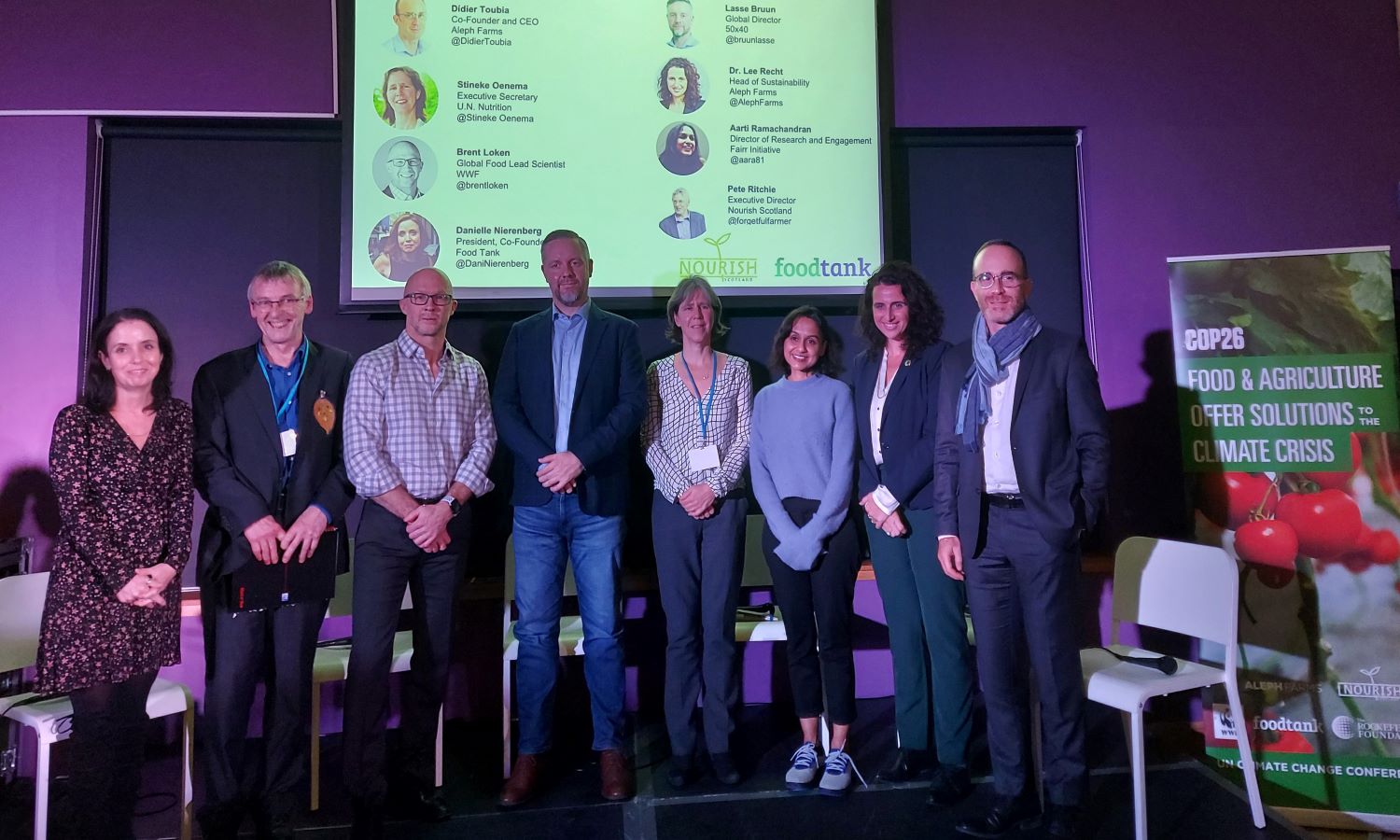Discussions around the way food from animals is produced and consumed have become increasingly contentious and binary. At the UN Climate Change Conference (COP26) Nourish Scotland Pavilion in Glasgow on November 9, experts gathered to discuss what it takes to produce animal protein more sustainably while maintaining farmers’ livelihoods and food security.
“Inherently as human beings, we tend to think in the framework of either/or,” says Didier Toubia, Co-Founder and CEO of cultivated meat company Aleph Farms. “It’s important to recognize that choices are not necessarily exclusive. These critical and important challenges are impacting all of us—the challenges are inclusive, not exclusive—and so the solutions should be inclusive as well.”
Especially in the last decade, the discourse surrounding the meat sector often oversimplifies a complex ecosystem down to good actors versus bad actors, says Toubia, but it’s important to think about the common issues all eaters are facing and how all sides can work together.
“We see cultivated meat as an evolution of agriculture rather than an opposing or conflicting approach,” says Toubia.
Cultivated meat products are grown directly from animal cells using natural tissue regeneration processes rather than slaughtering an entire animal. The process reduces greenhouse gas emissions by more than 90 percent, land use by more than 95 percent, and water use by close to 80 percent compared to intensively farming livestock, according to Aleph Farms.
Toubia says that cultivated meat gives consumers the ability to experience the culinary, sensory, and nutritional qualities of animal meat without slaughtering an animal—and while dramatically reducing the environmental impacts of the meat industry. But meat is a central part of many diets and cultures, and Aleph Farms sees cultivated meat producers working alongside, not in contention with, ranchers and livestock farmers.
“Beyond regenerative and sustainable animal farming practices, we do see cultivated meat as its own category of meat,” Toubia says. “The same as how we have red and white wine today, we believe that in 5 to 10 years, we’ll have the choice between two types of meat products,” such as those coming from a slaughtered animal versus cultivated meat.
As more investors look towards sustainability goals, the meat sector is increasingly under pressure to change industrialized practices for better human and environmental outcomes. Aarti Ramachandran, Director of Research & Engagements at FAIRR Initiative, says that “the fundamental thesis that [the meat sector] will continue to grow is now being challenged.”
UN Nutrition Executive Secretary Stineke Oenema notes that a range of diets—including those that incorporate meat, dairy, and seafood—can be both healthy and sustainable as well as economically feasible and culturally appropriate, and so a range of solutions can help build towards a more sustainable future meat sector.
“We need to eat less meat in the Global North, but we also need to drive less, we need to have smaller houses, we need to fly less…it’s about equity,” says Lasse Bruun CEO of 50by40, a collective impact organization aiming to cut the global production and consumption of industrialized animal agriculture by 50 percent by 2040.
“There is this rift between a so-called technical solution and adhering to principles of social justice. From my perspective, both are important and can be intertwined. We need to find a way to find a common ground to move this forward,” Bruun says. This means moving fast and innovating while incorporating an inclusive variety of solutions.
“The house is on fire, and unless we take all means to put out the fire, nobody is going to make it,” Bruun says.
As a livestock farmer himself, Nourish Scotland Executive Director Pete Ritchie says that often conversations surrounding meat lack an understanding of food and livestock systems, as well as how long systemic changes have historically taken.
“I do find the grandiosity of the, ‘we’re going to get rid of all livestock farmers tomorrow’ claims frankly ridiculous. Not all cows are the same, this is a very obvious thing,” Ritchie says. His own cows graze regeneratively in a low-input system, which builds soil health and has minimal impact on the surrounding ecosystem.
According to Ritchie, some kind of systemic transition is going to happen, but the key is to ensure that it isn’t too abrupt or doesn’t leave anyone behind. The transition to a more sustainable meat sector must find a place for all stakeholders in a circular economy, as opposed to the current system, which has “unimaginably horrible conditions” for meat industry workers.
“Everyone has a right to work that they feel good about,” says Food Tank President Danielle Nierenberg, “and right now, the livestock sector does not provide that work.”
Ritchie thinks public money can drive these positive public outcomes. And Lee Recht, Aleph Farms Vice President of Sustainability, agrees that policymakers can create incentives to meet common goals that include all stakeholders. So far, she thinks there hasn’t been enough emphasis on ways to work together.
“Moving forward is painful, it’s not an easy thing,” says Recht. “But there are over 1 billion people today with livelihoods relying on the meat sector, you cannot ignore that.”
Panelists agreed that business as usual is not an option. According to WWF Global Food Lead Scientist Brent Loken, consumption is the root cause of many issues surrounding sustainability.
“Greta Thunberg is the conscious of the youth, but Kylie Jenner is the influencer of the youth,” Loken says. “Until [overconsumption] becomes seen as unacceptable, I don’t think we’re going to be able to get anywhere.”
Loken thinks that everyone has a right to healthy and sustainable food, and the science says that it can be done. But rebalancing consumption patterns means increasing food access for more than 800 million people experiencing hunger each year while more affluent populations may have to change their behavior and reduce.
“This isn’t black-and-white, it’s very gray. It’s an uncomfortable conversation,” says Nierenberg, “but we need to embrace the uncomfortableness of it.”











